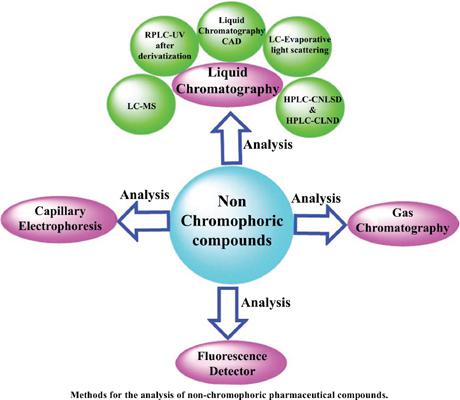Application of the Different Analytical Methods for Non-chromophoric Pharmaceutical Compounds
IF 1.5
4区 医学
Q4 PHARMACOLOGY & PHARMACY
引用次数: 0
Abstract
Abstract: The physicochemical properties of non-chromophoric compounds that lack a group to absorb UV-visible radiation make them difficult to analyze with a simple detector. Pharmaceutical formulations and their unknown impurities, which show weak or no response with a UV detector, remain undetected and pose a challenge to the analysis of these compounds. Direct measurement of a chromophore complex formed between the compound and the colored ions present in the electrolyte solution with UV detection is one of the validated methods to analyze non-chromophoric compounds. The derivatization with either chromophore or fluorescent group for the detection of the non-chromophoric compounds with HPLC-UV-Vis or fluorescence detector is also commonly used to study the physicochemical properties of the pharmaceutical formulations. The other techniques to analyze such non-chromophoric compounds include conductivity (ionic molecules), amperometry (molecules oxidized or reduced), mass spectrometry, evaporative light scattering detector (ELSD), condensation nucleation light scattering detector (CNLSD), capillary electrophoresis (CE), gas chromatography (GC), etc. This review covers various separation and detection techniques developed for the analysis of non-chromophoric compounds.

非显色性药物化合物不同分析方法的应用
摘要:非显色性化合物缺乏吸收紫外-可见辐射的基团,其物理化学性质使其难以用简单的检测器进行分析。药物制剂及其未知杂质对紫外检测器反应弱或无反应,因此无法检测到,这对这些化合物的分析构成了挑战。用紫外检测法直接测量化合物与电解质溶液中的有色离子之间形成的发色团络合物是分析非发色化合物的有效方法之一。用高效液相色谱-紫外-可见或荧光检测器检测非显色化合物时,与显色团或荧光基团的衍生化也常用于研究药物制剂的理化性质。其他分析这些非显色性化合物的技术包括电导率(离子分子)、安培(氧化或还原分子)、质谱、蒸发光散射检测器(ELSD)、凝聚成核光散射检测器(CNLSD)、毛细管电泳(CE)、气相色谱(GC)等。本文综述了用于分析非显色性化合物的各种分离和检测技术。
本文章由计算机程序翻译,如有差异,请以英文原文为准。
求助全文
约1分钟内获得全文
求助全文
来源期刊
CiteScore
1.50
自引率
0.00%
发文量
85
审稿时长
3 months
期刊介绍:
Aims & Scope
Current Pharmaceutical Analysis publishes expert reviews and original research articles on all the most recent advances in pharmaceutical and biomedical analysis. All aspects of the field are represented including drug analysis, analytical methodology and instrumentation. The journal is essential to all involved in pharmaceutical, biochemical and clinical analysis.

 求助内容:
求助内容: 应助结果提醒方式:
应助结果提醒方式:


